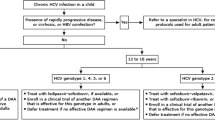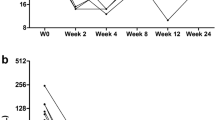Abstract
Background
Part 1 of the DORA study, a 2019 international clinical trial of glecaprevir and pibrentasvir (G/P) treatment in adolescents with chronic hepatitis C virus (HCV) infection, demonstrated high efficacy and safety. However, few reports have considered real-world experience with G/P treatment in adolescents with chronic HCV. The present prospective multicenter study assessed real-world efficacy and safety of G/P treatment in Japanese adolescents with chronic HCV.
Methods
Subjects between 12 and 17 years old who were treatment-naïve or previously managed with interferon-based regimens were prospectively enrolled and treated with G/P (300 mg/120 mg) once daily for 8 or 12 weeks. The primary efficacy endpoint was sustained virologic response at 12 weeks after treatment completion (SVR12). Adverse effects and laboratory abnormalities were assessed.
Results
Twenty-five Japanese patients (15 female) were enrolled from 13 pediatric centers in Japan. Median age was 13 years (range 12–17). Numbers of patients with genotypes 1b, 2a, 2b, and 2b/1b were 6, 12, 6, and 1, respectively. Twenty-two were treatment-naïve, while three had experienced interferon-based treatments. All patients completed G/P treatment (24 for 8 weeks and 1 for 12). Twenty-four achieved SVR12 (96%). Most adverse events were mild. None were serious. G/P significantly decreased serum alanine aminotransferase, γ‐glutamyltransferase, and Wisteria floribunda agglutinin-positive Mac-2-binding protein concentrations. No negative effects on growth or maturation were apparent at 12 weeks.
Conclusions
Under real-world conditions, G/P treatment of Japanese adolescents with chronic HCV was highly efficacious and well tolerated.

Similar content being viewed by others
Abbreviations
- AE:
-
Adverse event
- ALT:
-
Alanine aminotransferase
- APRI:
-
Aspartate aminotransferase-to-platelet ratio index
- BMI:
-
Body mass index
- DAA:
-
Direct-acting antiviral
- GGT:
-
γ‐Glutamyltransferase
- G/P:
-
Glecaprevir and pibrentasvir
- HCC:
-
Hepatocellular carcinoma
- HCV:
-
Hepatitis C virus
- HIV-1:
-
Human immunodeficiency virus-1
- INF:
-
Interferon
- M2BPGi:
-
Wisteria floribunda Agglutinin-positive Mac-2-binding protein
- PEG:
-
Pegylated
- RAS:
-
Resistance-associated substitution
- RBV:
-
Ribavirin
- SVR12:
-
Sustained virologic response at posttreatment week 12
References
Polaris Observatory HCV Collaborators. Global change in hepatitis C virus prevalence and cascade of care between 2015 and 2020: a modelling study. Lancet Gastroenterol Hepatol. 2022;7:396–415.
Schmelzer J, Dugan E, Blach S, et al. Global prevalence of hepatitis C virus in children in 2018: a modelling study. Lancet Gastroenterol Hepatol. 2020;5:374–92.
Tanaka J, Kurisu A, Ohara M, et al. Burden of chronic hepatitis B and C infections in 2015 and future trends in Japan: a simulation study. Lancet Reg Health West Pac. 2022;22:100428.
Mizuochi T, Takano T, Yanagi T, et al. Epidemiologic features of 348 children with hepatitis C virus infection over a 30-year period: a nationwide survey in Japan. J Gastroenterol. 2018;53:419–26.
Jonas MM, Rhee S, Kelly DA, et al. Pharmacokinetics, safety, and efficacy of glecaprevir/pibrentasvir in children with chronic HCV: part 2 of the DORA study. Hepatology. 2021;74:19–27.
Indolfi G, Fischler B, Gonzalez-Peralta RP, et al. Comparison of recommendations for treatment of chronic hepatitis C virus infection in children and adolescents: a position paper of the federation of international societies of pediatric gastroenterology, hepatology, and nutrition. J Pediatr Gastroenterol Nutr. 2020;70:711–7.
Indolfi G, Hierro L, Dezsofi A, et al. Treatment of chronic hepatitis c virus infection in children: a position paper by the hepatology committee of european society of paediatric gastroenterology, hepatology and nutrition. J Pediatr Gastroenterol Nutr. 2018;66:505–15.
Jonas MM, Squires RH, Rhee SM, et al. Pharmacokinetics, safety, and efficacy of glecaprevir/pibrentasvir in adolescents with chronic hepatitis C virus: part 1 of the DORA study. Hepatology. 2020;71:456–62.
Lampertico P, Carrión JA, Curry M, et al. Real-world effectiveness and safety of glecaprevir/pibrentasvir for the treatment of patients with chronic HCV infection: a meta-analysis. J Hepatol. 2020;72:1112–21.
Hayes CN, Imamura M, Tanaka J, et al. Road to elimination of HCV: clinical challenges in HCV management. Liver Int. 2022;42:1935–44.
Miura M, Maekawa S, Kadokura M, et al. Analysis of viral amino acids sequences and the IL28B SNP influencing the development of hepatocellular carcinoma in chronic hepatitis C. Hepatol Int. 2012;6:386–96.
Miura M, Maekawa S, Sato M, et al. Deep sequencing analysis of variants resistant to the non-structural 5A inhibitor daclatasvir in patients with genotype 1b hepatitis C virus infection. Hepatol Res. 2014;44:E360–7.
Isojima T, Kato N, Ito Y, et al. Growth standard charts for Japanese children with mean and standard deviation (SD) values based on the year 2000 national survey. Clin Pediatr Endocrinol. 2016;25:71–6.
Balistreri WF, Murray KF, Rosenthal P, et al. The safety and effectiveness of ledipasvir-sofosbuvir in adolescents 12–17 years old with hepatitis C virus genotype 1 infection. Hepatology. 2017;66:371–8.
Schwarz KB, Rosenthal P, Murray KF, et al. Ledipasvir-sofosbuvir for 12 weeks in Children 3 to <6 Years old with chronic hepatitis C. Hepatology. 2020;71:422–30.
Serranti D, Nebbia G, Cananzi M, et al. Efficacy of sofosbuvir/ledipasvir in adolescents with chronic hepatitis C genotypes 1, 3, and 4: A real-world study. J Pediatr Gastroenterol Nutr. 2021;72:95–100.
Uemura H, Uchida Y, Kouyama JI, et al. NS5A-P32 deletion as a factor involved in virologic failure in patients receiving glecaprevir and pibrentasvir. J Gastroenterol. 2019;54:459–70.
Singh AD, Maitra S, Singh N, et al. Systematic review with meta-analysis: impact of baseline resistance-associated substitutions on the efficacy of glecaprevir/pibrentasvir among chronic hepatitis C patients. Aliment Pharmacol Ther. 2020;51:490–504.
Sarrazin C. Treatment failure with DAA therapy: importance of resistance. J Hepatol. 2021;74:1472–82.
Izumi N, Takehara T, Chayama K, et al. Sofosbuvir-velpatasvir plus ribavirin in Japanese patients with genotype 1 or 2 hepatitis C who failed direct-acting antivirals. Hepatol Int. 2018;12:356–67.
Sezaki H, Suzuki F, Hosaka T, et al. Initial- and re-treatment effectiveness of glecaprevir and pibrentasvir for Japanese patients with chronic hepatitis C virus-genotype 1/2/3 infections. J Gastroenterol. 2019;54:916–27.
Tacke F, Klinker H, Boeker KHW, et al. Elevated liver enzymes predict morbidity and mortality despite antiviral cure in patients with chronic hepatitis C: data from the german hepatitis C-registry. Hepatol Commun. 2022. https://doi.org/10.1002/hep4.2015.
Singh S, Facciorusso A, Loomba R, et al. Magnitude and kinetics of decrease in liver stiffness after antiviral therapy in patients with chronic hepatitis C: a systematic review and meta-analysis. Clin Gastroenterol Hepatol. 2018;16:27-38.e4.
Ura K, Furusyo N, Ogawa E, et al. Serum WFA(+) -M2BP is a non-invasive liver fibrosis marker that can predict the efficacy of direct-acting anti-viral-based triple therapy for chronic hepatitis C. Aliment Pharmacol Ther. 2016;43:114–24.
Tajiri H, Suzuki M, Bessho K, et al. The role of serum Wisteria floribunda agglutinin-positive Mac-2 binding protein in the assessment of fibrosis in children with chronic hepatitis C. Sci Rep. 2022;12:11205.
Jonas MM, Balistreri W, Gonzalez-Peralta RP, et al. Pegylated interferon for chronic hepatitis C in children affects growth and body composition: results from the pediatric study of hepatitis C (PEDS-C) trial. Hepatology. 2012;56:523–31.
Acknowledgements
The authors thank Shintaro Ogawa at the Department of Virology and Liver Unit, Nagoya City University Graduate School of Medical Sciences for assisting with RASs analysis. We also thank all participating patients, their families, and their physicians for collaborating in data collection.
Funding
This work was supported by the Research Program on Hepatitis from the Japanese Agency for Medical Research and Development, AMED (22fk0210068h0003 and 22fk0210103).
Author information
Authors and Affiliations
Contributions
Conceptualization: TM. Formal analysis and investigation: TM and YT. Resources: all authors. Supervision: YY and HT. Funding acquisition: TM, YT, and HT. Writing-original draft: TM. Writing-review and editing: all authors. All authors read and approved the final manuscript.
Corresponding author
Ethics declarations
Conflict of interest
Tatsuki Mizuochi reports personal fees from AbbVie GK. Yasuhito Tanaka reports personal fees from Gilead Sciences Inc., Fujirebio Inc., and AbbVie GK; research grants from Gilead Sciences, Inc., Fujirebio Inc., AbbVie GK, and Board of Trustees of the Leland Stanford Junior University.
Ethics approval and consent to participate
This study protocol complied with the ethical guidelines of the Declaration of Helsinki and was approved by the Ethics Committee of Kurume University and its counterparts at other participating centers.
Additional information
Publisher's Note
Springer Nature remains neutral with regard to jurisdictional claims in published maps and institutional affiliations.
Supplementary Information
Below is the link to the electronic supplementary material.
Rights and permissions
Springer Nature or its licensor (e.g. a society or other partner) holds exclusive rights to this article under a publishing agreement with the author(s) or other rightsholder(s); author self-archiving of the accepted manuscript version of this article is solely governed by the terms of such publishing agreement and applicable law.
About this article
Cite this article
Mizuochi, T., Iwama, I., Inui, A. et al. Real-world efficacy and safety of glecaprevir/pibrentasvir in Japanese adolescents with chronic hepatitis C: a prospective multicenter study. J Gastroenterol 58, 405–412 (2023). https://doi.org/10.1007/s00535-023-01968-x
Received:
Accepted:
Published:
Issue Date:
DOI: https://doi.org/10.1007/s00535-023-01968-x




